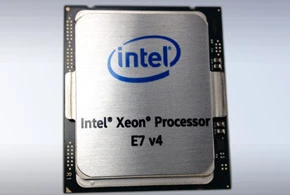
The vendor's new chips for four- and eight-socket systems bring performance and memory capacity improvements over the previous generation.
Intel is launching the latest version of its high-end Xeon E7 server processors with its eye firmly on the growing data analytics needs in the enterprise.Officials with the chip maker on June 6 unveiled the Xeon E7-8800/4800 v4 product families that are built on the company's "Broadwell-EX" core architecture and offer significant gains in such areas as performance and memory capacity, and target scale-up server environments. While the 14-nanometer chips can be applied to a broad range of mission-critical applications, such as data-intensive workloads such as online transaction processing (OLTP), supply chain management and enterprise resource planning (ERP), the primary aim is to make it easier, faster and more affordable for enterprises to collect and analyze in real time the massive amounts of structured and unstructured data being generated and to turn those analyses into actionable business decisions.The new Xeon E7s, which primarily target four- and eight-socket servers, will enable organizations to drive down overall capital and operation costs by getting more work done per system, therefore needing fewer systems, officials said. That will be important as the not only the amount of data grows, but also as the number of sources of that data proliferates."Data is only valuable if the money you get out of it is more than what you had to put in to get it," Frank Jensen, performance marketing manager for Intel's Data Center Group (DCG), said during a workshop about the upcoming Xeon E7 v4 processors in March. Systems vendors agree, as top OEMs—including Dell, Lenovo and Fujitsu—announced new and upgraded servers that will be powered by the new processors. The new chips come fewer than three months after Intel rolled out theeat latest iterations of the midrange Xeon E5 processors. The Xeon E5-2600 v4 chips are aimed at workstations and servers, with features that will enable businesses to more easily adopt cloud computing environments and managed the compute demand coming from mobile computing devices.With the new Xeon E7s, Intel officials are looking to drive the development of high-performing, highly-reliable servers that will enable enterprises manage the tidal wave of data coming at them, particularly from new sources such as the Internet of things (IoT). Trying to gain insight from data is nothing new, according to Ed Goldman, enterprise segment CTO of DCG. However, it is growing fast—67 percent expected growth between 2015 and 2020—he said."Analytics has been around for a long time," Goldman said during the March workshop. "As soon as applications began to exist, people have been analyzing them."However, the rapid growth in data is "significant to the portfolio and it's significant to what's going on in the market," he said.The new Xeon E7 v4 chips offer up to 24 cores per chip, more than the 18 cores on their predecessors. They also offer more instruction threads—48 for the new processors, to 36 to the Xeon E7 v3 chips—and up to 60MB of last-level cache. The previous chips offered up to 45MB. The 8800/4800 families include eight chips for a range of system types, as well as two chips optimized for the enterprise database market segment and another optimized processor for high-performance computing (HPC).The new processors also come with an array of new and enhanced features around virtualization, security, performance and RAS (reliability, availability and serviceability), officials said. They said the new chips not only offer improved performance when compared with the previous generation Xeon E7 processors, but also when tested against IBM's Power architecture. Benchmark tests show a 24-core Xeon E7 v4 bringing as much as 1.3 times the scaling of an 18-core predecessor.In addition, the deliver twice the memory support—up to 24TB—and twice as many analytics queries as the previous version. Intel officials also said enterprises can use fewer systems with the new chips to get the same amount of work done. A hundred 10-core, four-socket E7-4870 v1 processors can be replaced by 33 24-core, four-socket E7-8890 v4 chips, saving up to 92 percent in network and maintenance costs, 73 percent in power and cooling costs and 67 percent in software licensing, they said.
- eWeek